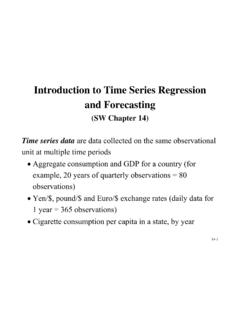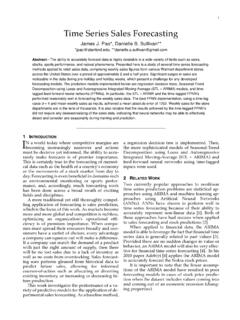Transcription of Introduction to Time Series and Forecasting, Second Edition
1 Introduction toTime Series and Forecasting, Second EditionPeter J. BrockwellRichard A. DavisSpringerThe Bartlett Press, Inc. brockwel 8 i 2002 1:59 Page iSpringer Texts in StatisticsAdvisors:George Casella Stephen Fienberg Ingram OlkinSpringerNew YorkBerlinHeidelbergBarcelonaHong KongLondonMilanParisSingaporeTokyoThis page intentionally left blank The Bartlett Press, Inc. brockwel 8 i 2002 1:59 Page iiiPeter J. Brockwell Richard A. DavisIntroductionto time Seriesand ForecastingSecond EditionWith 126 IllustrationsIncludes CD-ROM13 The Bartlett Press, Inc. brockwel 8 i 2002 1:59 Page ivPeter J. BrockwellRichard A. DavisDepartment of StatisticsDepartment of StatisticsColorado State UniversityColorado State UniversityFort Collins, CO 80523 Fort Collins, CO BoardGeorge CasellaStephen FienbergIngram OlkinDepartment of StatisticsDepartment of StatisticsDepartment of StatisticsGriffin-Floyd HallCarnegie Mellon UniversityStanford UniversityUniversity of FloridaPittsburgh, PA 15213-3890 Stanford, CA Box 118545 USAUSAG ainesville, FL 32611-8545 USAL ibrary of Congress Cataloging-in-Publication DataBrockwell, Peter to time Series and forecasting / Peter J.
2 Brockwell and Richard A. Davis. 2nd (Springer texts in statistics)Includes bibliographical references and 0-387-95351-5 (alk. paper)1. time - Series analysis. I. Davis, Richard A. II. Title. III. 5 dc212001049262 Printed on acid-free paper. 2002, 1996 Springer-Verlag New York, rights reserved. This work may not be translated or copied in whole or in part without the written permission ofthe publishers (Springer-Verlag New York, Inc., 175 Fifth Avenue, New York, NY 10010, USA), except for briefexcerpts in connection with reviews or scholarly analysis. Use in connection with any form of information storageand retrieval, electronic adaptation, computer software, or by similar or dissimilar methodology now known orhereafter developed is use of general descriptive names, trade names, trademarks, etc.
3 , in this publication, even if the former arenot especially identified, is not to be taken as a sign that such names, as understood by the Trade Marks andMerchandise Marks Act, may accordingly be used freely by managed by MaryAnn Brickner; manufacturing supervised by Joe by The Bartlett Press, Inc., Marietta, and bound by Donnelley and Sons, Harrisonburg, in the United States of 0-387-95351-5 SPIN 10850334 Springer-Verlag New York Berlin HeidelbergA member of BertelsmannSpringer Science+Business Media GmbHDisclaimer: This eBook does not include the ancillary media that waspackaged with the original printed version of the book. The Bartlett Press, Inc. brockwel 8 i 2002 1:59 Page vTo Pam and PattiThis page intentionally left blank The Bartlett Press, Inc.
4 Brockwel 8 i 2002 1:59 Page viiPrefaceThis book is aimed at the reader who wishes to gain a working knowledge of timeseries and forecasting methods as applied in economics, engineering and the naturaland social sciences. Unlike our earlier book, time Series :Theory and Methods, re-ferred to in the text as TSTM, this one requires only a knowledge of basic calculus,matrix algebra and elementary statistics at the level (for example) of Mendenhall,Wackerly and Scheaffer (1990). It is intended for upper-level undergraduate studentsand beginning graduate emphasis is on methods and the analysis of data sets. The student versionof the time Series package ITSM2000, enabling the reader to reproduce most of thecalculations in the text (and to analyze further data sets of the reader s own choosing),is included on the CD-ROM which accompanies the book.
5 The data sets used in thebook are also included. The package requires an IBM-compatible PC operating underWindows 95, NT version , or a later version of either of these operating program ITSM can be run directly from the CD-ROM or installed on a hard diskas described at the beginning of Appendix D, where a detailed Introduction to thepackage is little prior familiarity with computing is required in order to use the computerpackage. Detailed instructions for its use are found in the on-line help files whichare accessed, when the program ITSM is running, by selecting the menu optionHelp>Contentsand selecting the topic of interest. Under the headingDatayouwill find information concerning the data sets stored on the CD-ROM. The book canalso be used in conjunction with other computer packages for handling time 14 of the book by Venables and Ripley (1994) describes how to performmany of the calculations using are numerous problems at the end of each chapter, many of which involveuse of the programs to study the data sets make the underlying theory accessible to a wider audience, we have statedsome of the key mathematical results without proof, but have attempted to ensurethat the logical structure of the development is otherwise complete.
6 (References toproofs are provided for the interested reader.)The Bartlett Press, Inc. brockwel 8 i 2002 1:59 Page viiiviiiPrefaceSince the upgrade to ITSM2000 occurred after the first Edition of this bookappeared, we have taken the opportunity, in this Edition , to coordinate the text withthe new software, to make a number of corrections pointed out by readers of the firstedition and to expand on several of the topics treated only briefly in the first D, the software tutorial, has been rewritten in order to be compatiblewith the new version of the of the other extensive changes occur in (i) Section , which highlightsthe role of the innovations algorithm in generalized least squares and maximumlikelihood estimation of regression models with time Series errors, (ii)
7 Section ,where the treatment of forecast functions for ARIMA processes has been expandedand (iii) Section , which now includes GARCH modeling and simulation, topicsof considerable importance in the analysis of financial time Series . The new materialhas been incorporated into the accompanying software, to which we have also addedthe optionAutofit. This streamlines the modeling of time Series data by fittingmaximum likelihood ARMA(p, q)models for a specified range of(p, q)values andautomatically selecting the model with smallest AICC is sufficient material here for a full-year Introduction to univariate and mul-tivariate time Series and forecasting . Chapters 1 through 6 have been used for severalyears in introductory one-semester courses in univariate time Series at Colorado StateUniversity and Royal Melbourne Institute of Technology.
8 The chapter on spectralanalysis can be excluded without loss of continuity by readers who are so are greatly indebted to the readers of the first Edition and especially to MatthewCalder, coauthor of the new computer package, and Anthony Brockwell for theirmany valuable comments and suggestions. We also wish to thank Colorado StateUniversity, the National Science Foundation, Springer-Verlag and our families fortheir continuing support during the preparation of this Second Collins, ColoradoPeter J. BrockwellAugust 2001 Richard A. DavisThe Bartlett Press, Inc. brockwel 8 i 2002 1:59 Page ixContentsPrefacevii1. Examples of time Objectives of time Series Some Simple time Series Some Zero-Mean Models with Trend and A General Approach to time Series Stationary Models and the Autocorrelation The Sample Autocorrelation A Model for the Lake Huron Estimation and Elimination of Trend and Seasonal Estimation and Elimination of Trend in the Absence Estimation and Elimination of Both Trend Testing the Estimated Noise Sequence35 Problems402.
9 Stationary Basic Linear Introduction to ARMA Properties of the Sample Mean and Autocorrelation Estimation of Estimation of ( )and ( ) forecasting Stationary time The Durbin Levinson The Innovations Prediction of a Stationary Process in Terms of InfinitelyMany Past Values75 The Bartlett Press, Inc. brockwel 8 i 2002 1:59 Page The Wold Decomposition77 Problems783. ARMA ARMA(p,q) The ACF and PACF of an ARMA(p,q) Calculation of the The Autocorrelation The Partial Autocorrelation forecasting ARMA Processes100 Problems1084. Spectral Spectral The time -Invariant Linear The Spectral Density of an ARMA Process132 Problems1345. Modeling and forecasting with ARMA Preliminary Yule Walker Burg s The Innovations The Hannan Rissanen Maximum Likelihood Diagnostic The Graph of Rt,t 1.
10 ,n The Sample ACF of the Tests for Randomness of the Order The FPE The AICC Criterion171 Problems1746. Nonstationary and Seasonal time Series ARIMA Models for Nonstationary time Identification Techniques187 The Bartlett Press, Inc. brockwel 8 i 2002 1:59 Page Unit Roots in time Series Unit Roots in Unit Roots in Moving forecasting ARIMA The Forecast Seasonal ARIMA forecasting SARIMA Regression with ARMA OLS and GLS ML Estimation213 Problems2197. Multivariate time Second -Order Properties of Multivariate time Estimation of the Mean and Covariance Estimation of Estimation of (h) Testing for Independence of Two Stationary time Bartlett s Multivariate ARMA The Covariance Matrix Function of a Causal Best Linear Predictors of Second -Order Random Modeling and forecasting with Multivariate AR Estimation for Autoregressive Processes Using Whittle forecasting Multivariate Autoregressive Cointegration254 Problems2568.




![Google Cloud AI, USA arXiv:1912.09363v3 [stat.ML] 27 Sep 2020](/cache/preview/6/0/3/f/9/8/e/6/thumb-603f98e66448be95dc0f14f9f102a043.jpg)


